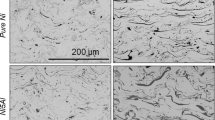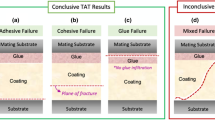Abstract
Adhesion of thermal spray (TS) coatings is an important system level property in coating design and application. Adhesive-based pull testing (ASTM C633) has long been used to evaluate coating/substrate bonding. However, this approach is not always suitable for high velocity spray coatings, for example, where adhesion strengths are routinely greater than the strength of the adhesive bonding agent used in the testing. In this work, a new approach has been proposed to evaluate the adhesion of TS coatings. A systematic investigation of the effects of substrate roughness on both the uniaxial tensile yield strength and traditional bond pull adhesive strength of HVOF Ni and Ni-5wt.%Al, as well as cold-sprayed Ni-coated laminates revealed a strong correlation between these two test methodologies for the respective materials and processes. This approach allows measurement of the adhesion response even where the adhesive method is not applicable, overcoming many of the issues in the traditional ASTM C633. Analysis of cracking patterns of the coatings after 10.5% strain was used to assess the adhesion and cohesion properties. The mechanisms which determine the load transfer between the substrate and the coating are also briefly discussed.








Similar content being viewed by others
References
Y.-Y. Wang, C.-J. Li, and A. Ohmori, Influence of Substrate Roughness on the Bonding Mechanisms of High Velocity Oxy-Fuel Sprayed Coatings, Thin Solid Films, 2005, 485(1), p 141-147
M. Mellali, P. Fauchais, and A. Grimaud, Influence of Substrate Roughness and Temperature on the Adhesion/Cohesion of Alumina Coatings, Surf. Coat. Technol., 1996, 81(2–3), p 275-286
M.F. Bahbou, P. Nylén, and J. Wigren, Effect of Grit Blasting and Spraying Angle on the Adhesion Strength of a Plasma-Sprayed Coating, J. Therm. Spray Technol., 2004, 13(4), p 508-514
H. Assadi, F. Gärtner, T. Stoltenhoff, and H. Kreye, Bonding Mechanism in Cold Gas Spraying, Acta Mater., 2003, 51(15), p 4379-4394
X. Zheng, M. Huang, and C. Ding, Bond Strength of Plasma-Sprayed Hydroxyapatite/Ti Composite Coatings, Biomaterials, 2000, 21(8), p 841-849
S. Sampath, G.A. Bancke, H. Herman, and S. Rangaswamy, Plasma Sprayed Ni–Al Coatings, Surf. Eng., 1989, 5(4), p 293-298
C.K. Lin and C.C. Berndt, Measurement and Analysis of Adhesion Strength for Thermally Sprayed Coatings, J. Therm. Spray Technol., 1994, 3(1), p 75-104
C.-J. Li and Y.-Y. Wang, Effect of Particle State on the Adhesive Strength of HVOF Sprayed Metallic Coating, J. Therm. Spray Technol., 2002, 11(4), p 523-529
Y.-Y. Wang, C.-J. Li, and A. Ohmori, Examination of Factors Influencing the Bond Strength of High Velocity Oxy-Fuel Sprayed Coatings, Surf. Coat. Technol., 2006, 200(9), p 2923-2928
R. Huang, W. Ma, and H. Fukanuma, Development of Ultra-Strong Adhesive Strength Coatings Using Cold Spray, Surf. Coat. Technol., 2014, 258, p 832-841
S. Sampath, X. Jiang, A. Kulkarni, J. Matejicek, D. Gilmore, and R. Neiser, Development of Process Maps for Plasma Spray: Case Study for Molybdenum, Mat. Sci. Eng. A, 2003, 348(1), p 54-66
S. Sampath, X.Y. Jiang, J. Matejicek, L. Prchlik, A. Kulkarni, and A. Vaidya, Role of Thermal Spray Processing Method on the Microstructure, Residual Stress and Properties of Coatings: an Integrated Study for Ni–5 wt%Al Bond Coats, Mat. Sci. Eng. A, 2004, 364(1–2), p 216-231
H.S. Rondeau, Spray Bonding of Nickel Aluminum and Nickel Titanium Alloys, US Patent 4,027,367, 1977
C.C. Berndt and C.K. Lin, Measurement of Adhesion for Thermally Sprayed Materials, J. Adhes. Sci. Technol., 1993, 7(12), p 1235-1264
A.S.M. Ang and C.C. Berndt, A Review of Testing Methods for Thermal Spray Coatings, Inter. Mater. Rev., 2014, 59(4), p 179-223
G.M. Smith, O. Higgins, and S. Sampath, In-Situ Observation of Strain and Cracking in Coated Laminates by Digital Image Correlation, Surf. Coat. Technol., 2017, 328, p 211-218
Y. Okajima, T. Nakamura, and S. Sampath, Effect of Powder Injection on the Interfacial Fracture Toughness of Plasma-Sprayed Zirconia, J. Therm. Spray Technol., 2013, 22(2–3), p 166-174
A. Vackel, T. Nakamura, and S. Sampath, Mechanical Behavior of Spay-Coated Metallic Laminates, J. Therm. Spray Technol., 2016, 25(5), p 1009-1019
G.M. Smith and S. Sampath, Sustainability of Metal Structures via Spray-Clad Remanufacturing, JOM, 2018, https://doi.org/10.1007/s11837-017-2676-0
X.-T. Luo, Y.-J. Li, C.-X. Li, G.-J. Yang, and C.-J. Li, Effect of Spray Conditions on Deposition Behavior and Microstructure of Cold Sprayed Ni Coatings Sprayed with a Porous Electrolytic Ni Powder, Surf. Coat. Technol., 2016, 289, p 85-93
J. Matejicek and S. Sampath, In Situ Measurement of Residual Stresses and Elastic Moduli in Thermal Sprayed Coatings: Part 1: Apparatus and Analysis, Acta Mater., 2003, 51(3), p 863-872
J. Matejicek, S. Sampath, D. Gilmore, and R. Neiser, In Situ Measurement of Residual Stresses and Elastic Moduli in Thermal Sprayed Coatings. Part 2: Processing Effects on Properties of Mo Coatings, Acta Mater., 2003, 51(3), p 873-885
S. Sampath, V. Srinivasan, A. Valarezo, A. Vaidya, and T. Streibl, Sensing, Control, and In Situ Measurement of Coating Properties: An Integrated Approach Toward Establishing Process-Property Correlations, J. Therm. Spray Technol., 2009, 18(2), p 243-255
A. Valarezo and S. Sampath, An Integrated Assessment of Process-Microstructure-Property Relationships for Thermal-Sprayed NiCr Coatings, J. Therm. Spray Technol., 2011, 20(6), p 1244-1258
S. Kuroda, Y. Tashiro, H. Yumoto, S. Taira, H. Fukanuma, and S. Tobe, Peening Action and Residual Stresses in High-Velocity Oxygen Fuel Thermal Spraying of 316L Stainless Steel, J. Therm. Spray Technol., 2001, 10(2), p 367-374
S. Deshpande, S. Sampath, and H. Zhang, Mechanisms of Oxidation and its Role in Microstructural Evolution of Metallic Thermal Spray Coatings—Case Study for Ni–Al, Surf. Coat. Technol., 2006, 200(18), p 5395-5406
R.B. Ross, Metallic Materials Specification Handbook, Springer, Berlin, 2013, p 1-831
J.-J. Tian, S.-W. Yao, X.-T. Luo, C.-X. Li, and C.-J. Li, An Effective Approach for Creating Metallurgical Self-Bonding in Plasma-Spraying of NiCr-Mo Coating by Designing Shell-Core-Structured Powders, Acta Mater., 2016, 110(Supplement C), p 19-30
F. Gärtner, T. Stoltenhoff, J. Voyer, H. Kreye, S. Riekehr, and M. Koçak, Mechanical Properties of Cold-Sprayed and Thermally Sprayed Copper Coatings, Surf. Coat. Technol., 2006, 200(24), p 6770-6782
X.-L. Gao and K. Li, A shear-Lag Model for Carbon Nanotube-Reinforced Polymer Composites, Int. J. Solids Struct., 2005, 42(5), p 1649-1667
J.A. Nairn and D.-A. Mendels, On the use of Planar Shear-Lag Methods for Stress-Transfer Analysis of Multilayered Composites, Mech. Mater., 2001, 33(6), p 335-362
T. Ganne, J. Crépin, S. Serror, and A. Zaoui, Cracking Behaviour of PVD Tungsten Coatings Deposited on Steel Substrates, Acta Mater., 2002, 50(16), p 4149-4163
F. Ahmed, K. Bayerlein, S. Rosiwal, M. Göken, and K. Durst, Stress Evolution and Cracking of Crystalline Diamond Thin Films on Ductile Titanium Substrate: Analysis by Micro-Raman Spectroscopy and Analytical Modelling, Acta Mater., 2011, 59(14), p 5422-5433
S. Frank, U.A. Handge, S. Olliges, and R. Spolenak, The Relationship Between Thin Film Fragmentation and Buckle Formation: Synchrotron-Based In Situ Studies and Two-Dimensional Stress Analysis, Acta Mater., 2009, 57(5), p 1442-1453
Acknowledgements
The authors would like to thank Yu-Juan Li at the State Key Laboratory for Mechanical Behavior of Materials, Xi’an Jiaotong University for fabrication of the CS Ni coatings under the financial support of the National Science Fund of China (51401158), China Postdoctoral Science Found (2014M550486), and the Natural Science Foundation of Shannxi Province, China (2015JQ5200). Additionally, the authors would like to thank the Industrial Consortium for Thermal Spray Technology at Stony Brook University in part for their support of the Center’s research activities.
Author information
Authors and Affiliations
Corresponding author
Additional information
Xiaotao Luo is on leave from State Key Laboratory for Mechanical Behavior of Materials, Xi’an Jiaotong University, Xi’an, China.
Appendix
Appendix
The stress distribution in a single coating segment was estimated by a one-dimensional “shear-lag” model. The coating/substrate system is schematically shown in Fig. 9, in which Cartesian coordinates are used. The coating is bonded to the substrate at y = 0, and the free surfaces of the substrate and the coating are located at y = −s and y = h, respectively. Origin (x = 0, y = 0) is located at the center of the segment. The maximum normal stress (σmax) in a coating segment can be calculated by:
where v is the Poison’s ratio, E the elastic modulus, and \(\sigma_{\text{res}}\) the residual stress in the coating. The subscripts s and c denote the substrate and coating, respectively. According to Frank et al. (Ref 34), the stress distribution along the tensile direction (x) and evolution in the coating segment follows:
where,
Because both sides of the substrate are coated in this study, the half thickness of the substrate is taken as s.
The interfacial shear stress, τ is governed by:
Rights and permissions
About this article
Cite this article
Luo, X., Smith, G.M. & Sampath, S. On the Interplay Between Adhesion Strength and Tensile Properties of Thermal Spray Coated Laminates—Part I: High Velocity Thermal Spray Coatings. J Therm Spray Tech 27, 296–307 (2018). https://doi.org/10.1007/s11666-018-0695-1
Received:
Revised:
Published:
Issue Date:
DOI: https://doi.org/10.1007/s11666-018-0695-1





